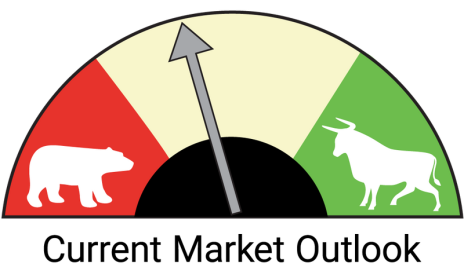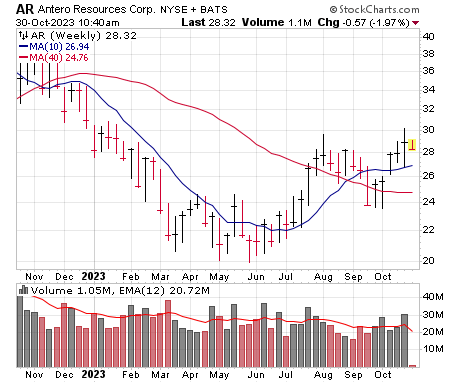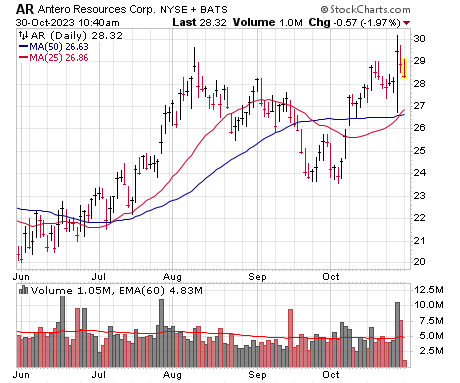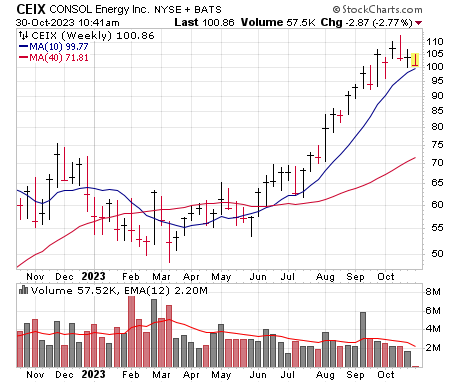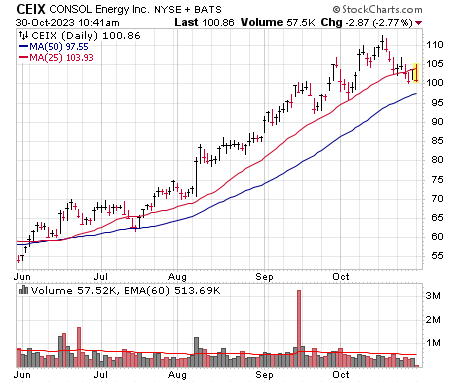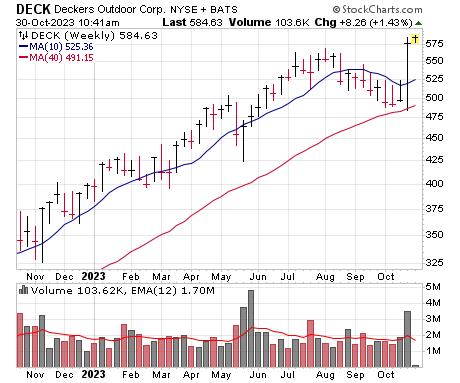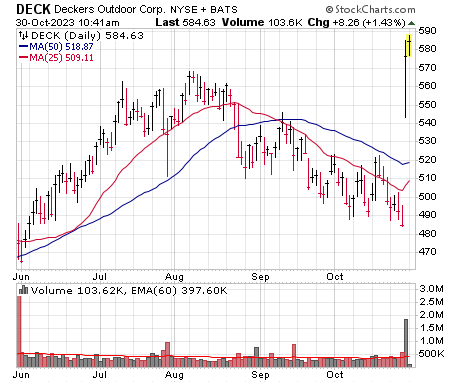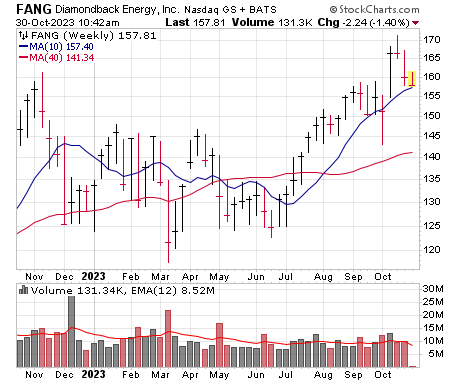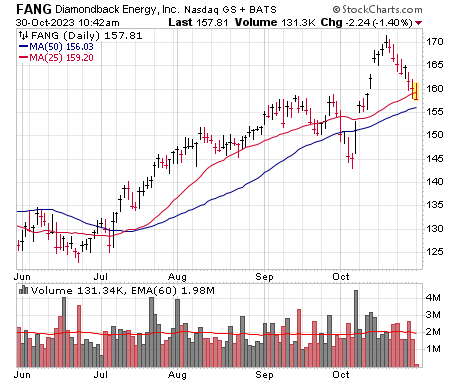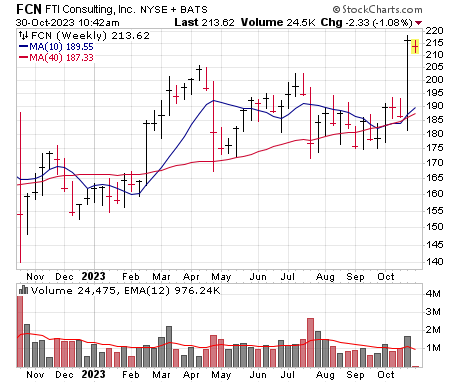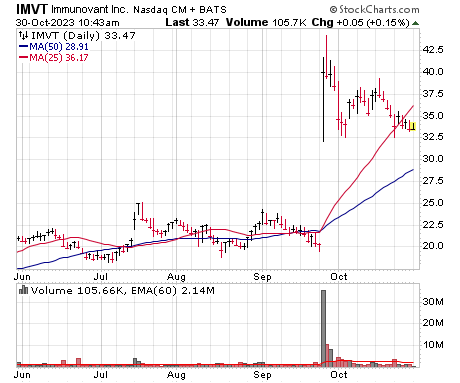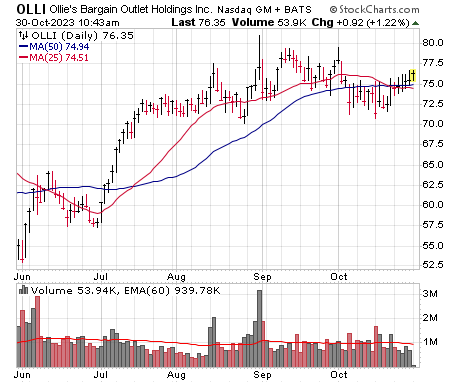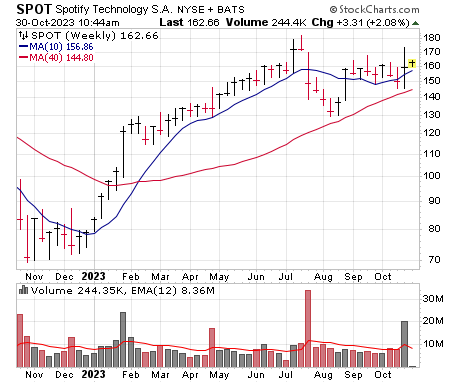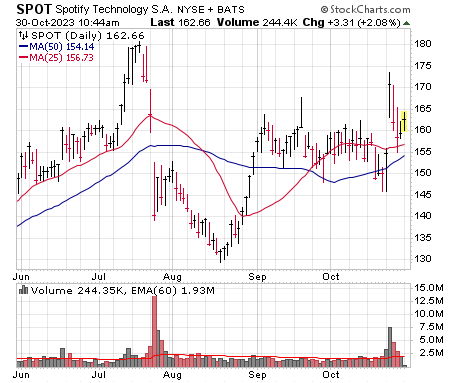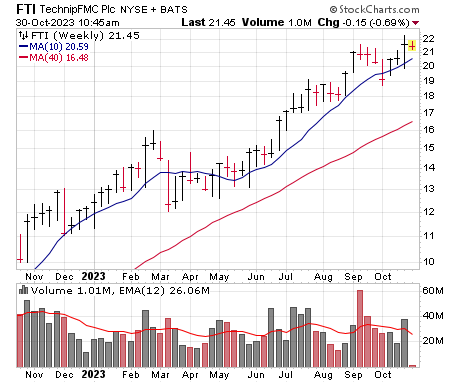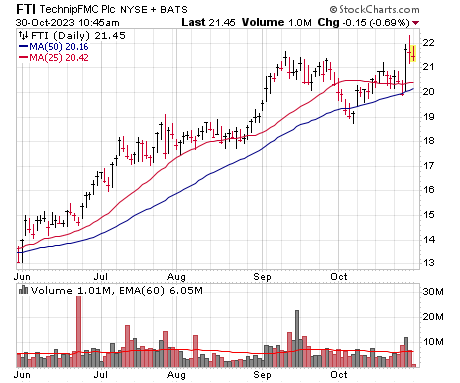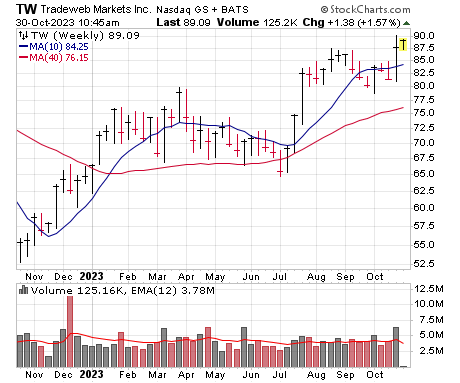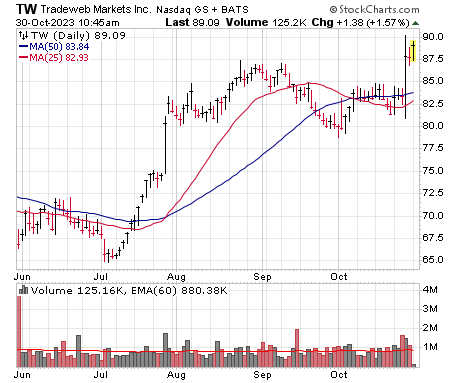Stay Cautious—and Alert
There’s not much new to say when it comes to the market—just about all of the primary evidence remains bearish, with the trends of the major indexes and most stocks pointed down and hundreds of stocks hitting new lows each day, vs. just a couple handfuls hitting new highs. Plus, let’s not forget that interest rates are still in a firm uptrend, too. Now, there are a growing number of secondary measures that are flashing green, effectively saying things are getting so extreme on the downside that, historically, a solid bounce (and maybe more) should be coming soon. Thus, we’re staying alert and keeping a list of resilient stocks and sectors, as we still think a sustained uptrend is possible if a couple of things go right in the world. But at the risk of repeating ourselves, we have to see the buyers show up for more than a few hours to start thinking investor perception is truly changing for the better. We’re staying cautious and leaving our Market Monitor at a level 4.
This week’s list has more than a few familiar names, including some initial earnings winners. Our Top Pick is Deckers Outdoors (DECK), which is a steady performer that also is showing great growth thanks to both of its top-selling brands—and the stock just emerged from nearly three months of chopping lower on its report. Try to buy on dips.
Price |
| Antero Resources (AR) |
| Consol Energy (CEIX) |
| Deckers Outdoors (DECK) ★ Top Pick ★ |
| Diamondback Energy (FANG) |
| FTI Consulting (FCN) |
| Immunovant (IMVT) |
| Ollie’s Bargain Outlet (OLLI) |
| Spotify Technology (SPOT) |
| TechnipFMC (FTI) |
| Tradeweb Markets (TW) |
Stock 1
Antero Resources (AR)
Price |
Why the Strength
With the Middle East in a tense situation, all eyes are on oil prices, which makes sense—but even so, natural gas may provide more of an opportunity, given that the commodity just had a horrid bear phase, falling 80% and staying down for months before recently picking up steam. Antero Resources is one of the purest plays on natural gas, especially in Appalachia—according to management, it has a ridiculous 22 years’ worth of drilling inventory that’s profitable even at $2.75 natural gas, and like most of the best players in the energy patch, Antero is also very capital efficient, with the ability to quickly reduce CapEx when conditions are unfavorable (this year’s $900 million initial spend estimate is now set for a “material reduction” given the lower prices that have existed). Of course, that doesn’t mean commodity prices have no effect, but even when in the basement, the firm is holding its own—in Q3, when gas averaged about $2.70, Antero was still profitable on an earnings basis and basically breakeven ($23 million loss) in terms of free cash flow. Thus, if this gas rally is for real (currently above $3.30), the benefits of higher prices should fall to the bottom line, allowing Antero to return some to shareholders (share buybacks were the preferred method when times were good; Q3 share count was off 4.4% from the year before). Thus, the story is very straightforward: Antero is one of the most efficient and direct plays on natural gas, so if that commodity is truly coming out of its long bear phase, cash flow and earnings here should explode. Indeed, analysts see 2024’s bottom line north of $2.50 per share, and even that could prove conservative given the CapEx discipline here.
Technical Analysis
AR peaked during the spring of last year near 48 when natural gas prices were at nosebleed levels, and then slid all the way to 20 as the commodity imploded. But since the start of May, the stock has put in some solid work: There were a few weeks of bottoming before a five-week rally saw shares test the 30 level, and while AR pulled back into September, it did so on light volume and has since rallied another five weeks in a row back to its highs, highlighted by last Thursday’s solid earnings reaction. There’s still overhead and the market is a mess, of course, but if you’re game, you could nibble here, use a stop under last week’s lows and consider averaging up if the buyers take control.
| Market Cap | $8.68B | EPS $ Annual (Dec) | ||
| Forward P/E | 11 | FY 2021 | 1.44 | |
| Current P/E | 22 | FY 2022 | 5.41 | |
| Annual Revenue | $5.58B | FY 2023e | 0.80 | |
| Profit Margin | 2.3% | FY 2024e | 2.61 | |
| Qtrly Rev | Qtrly Rev Growth | Qtrly EPS | Qtrly EPS Growth | |
| ($B) | (vs. yr-ago-qtr) | ($) | (vs. yr-ago-qtr) | |
| Latest qtr | 1.13 | -45% | 0.08 | -95% |
| One qtr ago | 0.95 | -57% | -0.28 | N/A |
| Two qtrs ago | 1.41 | 79% | 0.50 | -57% |
| Three qtrs ago | 2.09 | -13% | 1.04 | 126% |
Weekly Chart | Daily Chart |
Stock 2
Consol Energy (CEIX)
Price |
Why the Strength
A “perfect storm” of factors have converged to increase coal demand, including increased industrial usage of coal in China and seasonal stocking as that country’s power utilities prepare for the winter heating season; production disruptions in major producer Australia; plus heightened geopolitical risk for natural gas (the big competition in electricity production) in the wake of the Middle East and Eastern Europe wars. Collectively, these variables are making the nonrenewable energy source a lot more attractive, particularly for users in Asia. Pennsylvania-based Consol is a producer and exporter of high-BTU bituminous thermal and metallurgical (met) coal, owning and operating some of the most important and productive longwall mining operations in the U.S., as well as one of the Eastern seaboard’s largest export terminals. This year has witnessed all-time records for worldwide coal production and consumption, with seaborne trade expected to exceed 2019’s record of 1.3 million tons, according to the International Energy Agency (IEA). Exports accounted for nearly 80% of Consol’s recurring revenues in Q2, and the company has been shipping cargo to new customers in India, China and Indonesia. Further underscoring the extent of the global demand growth for thermal coal, all of Consol’s 2023 production was contracted in the first half of this year, while more than 75% of total production for next year has already been contracted as the firm pursues a strategic shift away from domestic markets and toward export demand growth. In Q2, Consol reported total sales of over $660 million (up 21% year-on-year) and earnings of $4.96 a share (up 40%). When Q3 earnings are released before the market opens on Tuesday (October 31), analysts expect sales and earnings increases of 5% and 12%, respectively, and while Wall Street sees the bottom line fading in 2024, it should remain in nosebleed territory.
Technical Analysis
CEIX actually had a big run for the first half of 2022, peaking in July and getting high in November, kicking off a multi-month launching pad. The breakout came on Q2 earnings in early August, and the stock really just took off from there, never dipping below the 25-day line and peaking at 112 two weeks ago. The dip since then has been normal, though earnings tomorrow morning will be key—we think a rally off this pullback would be buyable.
| Market Cap | $3.30B | EPS $ Annual (Dec) | ||
| Forward P/E | 5 | FY 2021 | 0.96 | |
| Current P/E | 5 | FY 2022 | 13.07 | |
| Annual Revenue | $2.55B | FY 2023e | 21.85 | |
| Profit Margin | 25.4% | FY 2024e | 17.88 | |
| Qtrly Rev | Qtrly Rev Growth | Qtrly EPS | Qtrly EPS Growth | |
| ($M) | (vs. yr-ago-qtr) | ($) | (vs. yr-ago-qtr) | |
| Latest qtr | 661 | 21% | 4.94 | 40% |
| One qtr ago | 689 | 92% | 6.55 | N/A |
| Two qtrs ago | 637 | 33% | 5.39 | 59% |
| Three qtrs ago | 562 | 277% | 4.25 | N/A |
Weekly Chart | Daily Chart |
Stock 3
Deckers Outdoors (DECK) ★ Top Pick ★
Price |
Why the Strength
Deckers is known for the premium footwear it designs and sells, including its staple brand Ugg (the iconic fuzzy boots and slippers) and the trendy Hoka brand of running shoes. Last week’s earnings report for fiscal Q2 2024 (ending September 30) accounts for the stock’s eye-catching performance, with management praising both brands for driving “exceptional performance” and producing record revenue and earnings in both Q2 and the first half of fiscal 2024. Total sales in Q2 increased 25% from a year ago and eclipsed $1 billion for the first time in the September quarter, while earnings of $6.82 a share beat estimates by a whopping 54%. By brand, Ugg revenue increased 28%, to $610 million, while Hoka sales jumped 27%, to $424 million, with sales for both brands being powered by “high levels of full-price consumer demand.” (Deckers’ other brands, Teva and Sanuk, also saw respective 28% sales increases, albeit at much smaller volumes). Although Ugg is Decker’s biggest brand and accounts for more than half its annual sales, the Hoka brand has been a big growth driver for Deckers lately and is rapidly catching up to Ugg, accounting for 40% of last year’s revenue. On that score, the top brass drew attention to the fiscal-year-to-date performance of both major brands last week, pointing out that sales across all channels grew 19%, driven by Hoka increasing 27% “from global strength across its ecosystem of access points.” By comparison, Ugg sales grew “only” 18%, mainly from gains across international regions. As a result, the company’s long-term strategy revolves around growing Hoka into a multibillion-dollar performance brand, while further growing Ugg through direct-to-consumer channels. Looking ahead, Wall Street sees 12%-ish top-line growth in each of the next three years, though as seen in the latest report, Deckers repeatedly tops expectations.
Technical Analysis
DECK rounded out a bear market low last May—well before the bottom in the major indexes later that year. After this, the stock wasted little time in getting a new uptrend started in July, rising from the low at 225 and continuing to chug ahead with new highs for the next 13 months before hitting the wall this past August at 565. Several weeks of correcting followed, with shares touching down at the 200-day line last week (nearly to the penny) before immediately ending the decline thanks to the powerful earnings gap. If you want in, aim for dips.
| Market Cap | $15.1B | EPS $ Annual (Mar) | ||
| Forward P/E | 24 | FY 2022 | 16.26 | |
| Current P/E | 21 | FY 2023 | 19.37 | |
| Annual Revenue | $3.91B | FY 2024e | 23.60 | |
| Profit Margin | 16.4% | FY 2025e | 26.45 | |
| Qtrly Rev | Qtrly Rev Growth | Qtrly EPS | Qtrly EPS Growth | |
| ($B) | (vs. yr-ago-qtr) | ($) | (vs. yr-ago-qtr) | |
| Latest qtr | 1.09 | 25% | 6.82 | 79% |
| One qtr ago | 0.68 | 10% | 2.41 | 45% |
| Two qtrs ago | 0.79 | 8% | 3.46 | 38% |
| Three qtrs ago | 1.35 | 13% | 10.48 | 24% |
Weekly Chart | Daily Chart |
Stock 4
Diamondback Energy (FANG)
Price |
Why the Strength
Diamondback Energy is a very straightforward story, with two clear reasons why the stock remains resilient. The first is oil prices and the firm’s dynamic economics, which promise to spin off monstrous free cash flow if oil remains anywhere near current levels (mid-$80 range). First, the business itself has always been one of the most efficient oil-heavy operators out there, which recently has meant rising production per share (up 14% from a year ago) even as the capital budget remains tight (cash operating expenses down 8% per barrel produced). And that’s led to massive and sustainable cash flow—for 2023 as a whole, $80 oil will lead to a total of $16 per share or so of free cash flow, at least three-quarters of which will be returned via a base dividend (2.1% yield, safe down to $43 oil), a variable dividend and share buybacks. (The balance sheet is also in good shape, with no debt maturities until 2026.) Then there’s the M&A angle: Exxon’s buyout of Pioneer along with Chevron’s acquisition of Hess in recent weeks has the entire oil sector—and especially those with big exposure to areas of the Permian, like Diamondback, which has more than 8,000 drilling locations in the Midland and Delaware basins that are economical at $50 oil—in the market’s view as potential targets. Of course, the buyout game is very hit or miss, but Diamondback has a lot going for it on its own, with buoyant returns a solid bet for a long time to come. Earnings (and the next dividend announcement) are due November 6.
Technical Analysis
FANG based out from last November through the first half of the year, but began to turn up after that, with a weekly volume cluster in July kicking off a rally that brought shares back near their old highs near Labor Day. The early-October shakeout in the group did take a toll, but FANG’s snapback from there (aided by the Exxon buyout of Pioneer) was more than impressive. Of course, shares have slipped of late as the market dragged everything down, but we see a potential setup—we’ll set our entry range up a few points from here, with the idea that a strong bounce off the 10-week line would bring higher prices and offer a good risk/reward situation.
| Market Cap | $28.5B | EPS $ Annual (Dec) | ||
| Forward P/E | 9 | FY 2021 | 11.27 | |
| Current P/E | 8 | FY 2022 | 24.04 | |
| Annual Revenue | $8.32B | FY 2023e | 18.27 | |
| Profit Margin | 34.9% | FY 2024e | 21.23 | |
| Qtrly Rev | Qtrly Rev Growth | Qtrly EPS | Qtrly EPS Growth | |
| ($B) | (vs. yr-ago-qtr) | ($) | (vs. yr-ago-qtr) | |
| Latest qtr | 1.92 | -31% | 3.68 | -48% |
| One qtr ago | 1.93 | -20% | 4.10 | -21% |
| Two qtrs ago | 2.03 | 0% | 5.29 | 46% |
| Three qtrs ago | 2.44 | 28% | 6.48 | 120% |
Weekly Chart | Daily Chart |
Stock 5
FTI Consulting (FCN)
Price |
Why the Strength
FTI has earned a reputation for being one of the world’s best troubleshooters for corporate clients—it has helped big firms like Yahoo deal with data breaches, Wells Fargo with consumer fraud investigations and AT&T/Time Warner with antitrust clearance. FTI also has one of the largest restructuring businesses in the U.S., providing corporate finance and business turnaround services (which makes it a play on a weakening economy) along with cybersecurity, legal support and other services. A stellar Q3 report featuring record revenue and earnings was the reason for the stock’s strength, led by sales of almost $900 million that rose 15% from a year ago due to higher demand in four of FTI’s six reporting segments, plus higher billing rates. Earnings per share of $2.34 beat estimates by 50 cents, with EBITDA of nearly $120 million (13% of revenues) increasing 20% from last year’s Q3. In last week’s earnings call, management said it’s focused on revenue growth and emphasized that the firm’s top line has been “terrifically on track” all year and is up 13% year-to-date, which it said is especially impressive in view of the market environment that has been “challenging for many professional services firms.” FTI further noted that its recent talent acquisitions and partnerships contributed to the sales and earnings growth despite the slower environment. Going forward, the company raised the lower end of its full-year 2023 top- and bottom-line guidance, with the former expected to increase 12% and the latter to rise 4%. Wall Street sees even more growth ahead, with meaningful low-double-digit earnings increases for both 2024 and 2025, with upside should the iffy economy (the two largest segments here are economic consulting and corporate restructuring) bring more firms to FTI’s doors for help.
Technical Analysis
FCN has been mostly waterlogged in the past year, with some sharp dips and rallies, but net-net, the stock was actually down a bit from its peak of July 2022 until two weeks ago. But the most recent few weeks did have some encouraging signs, such as tight, low-volume trading near key support (40-week line). And then, of course, we have last Thursday’s earnings gap, bringing FCN to new price and RP peaks. We’re OK with a nibble on dips if you want in.
| Market Cap | $7.35B | EPS $ Annual (Dec) | ||
| Forward P/E | 27 | FY 2021 | 6.76 | |
| Current P/E | 31 | FY 2022 | 6.77 | |
| Annual Revenue | $3.34B | FY 2023e | 7.03 | |
| Profit Margin | 9.3% | FY 2024e | 8.14 | |
| Qtrly Rev | Qtrly Rev Growth | Qtrly EPS | Qtrly EPS Growth | |
| ($M) | (vs. yr-ago-qtr) | ($) | (vs. yr-ago-qtr) | |
| Latest qtr | 893 | 15% | 2.34 | 9% |
| One qtr ago | 865 | 15% | 1.75 | 22% |
| Two qtrs ago | 807 | 11% | 1.34 | -19% |
| Three qtrs ago | 774 | 15% | 1.52 | 35% |
Weekly Chart | Daily Chart |
Stock 6
Immunovant (IMVT)
Price |
Why the Strength
Immunovant is a clinical-stage biopharmaceutical outfit focused on treatments for rare autoimmune diseases. Its innovative compound is called batoclimab which is a novel monoclonal antibody targeting the neonatal fragment crystallizable receptor – FcRn – where harmful autoantibodies, or harmful IgG, are sustained in the body; Immunovant has 22 treatments it’s pursuing around FcRns. Most far along for batoclimab are Phase 3 trials for the treatment of thyroid eye disease and myasthenia gravis, which have about 18,000 and 60,000 addressable patients in the U.S., respectively. But that’s not the source of the stock’s strength: Investors got very excited last month when the company announced strong Phase 1 trial results for what is expected to be a similar, but superior, new compound, IMVT-1402. The early results show IMVT-1402 being as effective as batoclimab in reducing harmful target FcRns with no discernible effect on albumin and LDL cholesterol. The treatment is fairly simple, too, since it’s just a subcutaneous injection. This suggests the company has found a superior treatment to batoclimab, one that should open up new markets as well as let the company replace batoclimab in some developing treatments where 1402 should be superior, such as for Graves disease therapy (in Phase 2 trials). Batoclimab for thyroid eye disease will continue in its trials, since the expected improvement there is small. To be fair, this remains a speculative situation, as Immunovant is some time from seeing a drug get to market, possibly late 2025, with no revenue expected this year or next. However, the company had $329 million cash on hand at the end of the June quarter, and just raised another $492 million in an oversubscribed share offering, giving it plenty of capital to keep funding trials and make some early preparations for drug submission and launches.
Technical Analysis
After going public via a SPAC merger in 2019, IMVT soared as high as 55 during the craziness, fell to 3.5 during last year’s bear and then recovered to 20 in early January of this year. After that, the stock had some downs and ups, but net-net, shares were still at 20 in mid-September. But then the trial results changed everything, with IMVT exploding as high as 44 on the news, and while the stock has dipped since then, it looks normal given the market’s malaise. We’ll set our buy range up from here in this volatile name, looking for a resumption of the buying pressures to get in.
| Market Cap | $4.76B | EPS $ Annual (Mar) | ||
| Forward P/E | N/A | FY 2022 | -1.43 | |
| Current P/E | N/A | FY 2023 | -1.71 | |
| Annual Revenue | Nil | FY 2024e | -1.86 | |
| Profit Margin | N/A | FY 2025e | -1.93 | |
| Qtrly Rev | Qtrly Rev Growth | Qtrly EPS | Qtrly EPS Growth | |
| ($M) | (vs. yr-ago-qtr) | ($) | (vs. yr-ago-qtr) | |
| Latest qtr | Nil | N/M | -0.57 | N/A |
| One qtr ago | Nil | N/M | -0.46 | N/A |
| Two qtrs ago | Nil | N/M | -0.49 | N/A |
| Three qtrs ago | Nil | N/M | -0.41 | N/A |
Weekly Chart | Daily Chart |
Stock 7
Ollie’s Bargain Outlet (OLLI)
Price |
Why the Strength
We’ve written up Ollie’s a couple of other times this year, as the firm’s been in the midst of a fundamental turnaround and the stock acts like it wants to go higher if the market lets it (see more on that below). To recap, the firm’s motto is Good Stuff Cheap, which basically explains the business—it’s the largest closeout retailer out there with 500 or so locations, offering brand-name goods at 20% to 70% below retail prices in tons of categories, which is obviously a boon to consumers. But Ollie’s is also a key player for retailers, giving them an outlet for inventory management and closeout merchandise, with the top brass here seeing a growing availability of deals as the environment gets more uncertain and as the firm deepens its relationships with big brands. A slew of hiccups from the pandemic and other things hurt results for a while, but now business is cranking ahead and margins look to be getting back to their historical norms: The July quarter not only saw overall sales rise 14%, but same-store sales lifted a strong 7.9% while EBITDA margins boomed to 12.9%, more than double last year’s figures; further “catch up” in those margins should keep big investors interested. But there’s more than that—Ollie’s has always had a great cookie-cutter story, ending July with 482 locations, expects to open 23 in the October quarter alone and it usually expands the store count by double-digit percentage totals, with a long-term goal of 1,050 stores (which itself could be conservative). It’s not going to grow at 50% clips, but Ollie’s story looks to be back on track after a couple of years in the wilderness, resulting in steady, reliable growth for a long time to come.
Technical Analysis
We wrote up OLLI at the start of the month, with the stock knocking on the door of new recovery highs—we wanted to enter on a breakout, but that didn’t happen, so there was no trade. The setup nearly a month later isn’t quite as pristine, but given the market’s implosion, it’s pretty solid: OLLI reached a new relative performance line peak last Friday and today and is just a couple of points below some resistance. We’ll again set our buy range up from here, thinking a powerful lift (likely alongside a rally in the general market) would lead to good things.
| Market Cap | $4.69B | EPS $ Annual (Jan) | ||
| Forward P/E | 28 | FY 2022 | 2.36 | |
| Current P/E | 32 | FY 2023 | 1.62 | |
| Annual Revenue | $1.94B | FY 2024e | 2.72 | |
| Profit Margin | 8.1% | FY 2025e | 3.07 | |
| Qtrly Rev | Qtrly Rev Growth | Qtrly EPS | Qtrly EPS Growth | |
| ($M) | (vs. yr-ago-qtr) | ($) | (vs. yr-ago-qtr) | |
| Latest qtr | 515 | 14% | 0.67 | 205% |
| One qtr ago | 459 | 13% | 0.49 | 145% |
| Two qtrs ago | 550 | 10% | 0.84 | 22% |
| Three qtrs ago | 418 | 9% | 0.37 | 9% |
Weekly Chart | Daily Chart |
Stock 8
Spotify Technology (SPOT)
Price |
Why the Strength
Spotify is the world’s largest streaming service, with management forecasting the business will tally more than 600 million monthly active users (MAUs) by the end of the year. The gains are coming even as Sportify has been raising prices in many of its markets (albeit for the first time in years), with the business having 226 million paying subscribers in Q3, ended September, who contributed the bulk of revenue, €2.9 billion ($3.1 billion). This year is shaping up to be one of the best for net paying subscriber additions with about 30 million expected, compared to 20 million forecast to start the year. The balance of customers are users of Spotify’s free, ad-supported tier, which generated €447 million in sales. Though the ad tier is smaller, it is growing at a faster rate, thanks to good ad-rate growth, especially in podcasts. The business is rolling out AI deejays in many markets to not only improve the algorithm that feeds listeners songs they want to hear but also act like a radio host through a natural sounding computerized voice that introduces and contextualizes songs. Spotify is also expanding into audio books, which promises to have higher margins than music. Throw in a focus on cost controls and with some activist investors involved, all of it has Wall Street expecting full-year 2023 sales to rise 14% to €13.3 billion ($14.1 billion), with gross margin rising about a percentage point to 26%, from 25% last year. The business still loses money on an accounting basis, though Q3 saw the first net income in three years, and free cash flow is regularly in the black and should grow going ahead. All told, Spotify looks to be in the middle innings of a powerful turnaround situation.
Technical Analysis
SPOT emerged from its bear phase early in 2023 and enjoyed an orderly rally until a disappointing Q2 earnings report brought in the sellers. The pullback was sharp (29% in just one month’s time), but the 40-week line offered support, and after a quick bounce the stock traded tightly for a few weeks. We aimed to get in on strength earlier this month but missed our buy range—though it gapped up on the Q3 report soon afterwards, before again being pulled down by the market. We’ll again set our buy range up from here, looking for follow-through buying pressures to get in.
| Market Cap | $30.9B | EPS $ Annual (Dec) | ||
| Forward P/E | 110 | FY 2021 | -0.20 | |
| Current P/E | N/A | FY 2022 | -2.39 | |
| Annual Revenue | $13.7B | FY 2023e | -2.27 | |
| Profit Margin | 1.9% | FY 2024e | 1.45 | |
| Qtrly Rev | Qtrly Rev Growth | Qtrly EPS | Qtrly EPS Growth | |
| ($B) | (vs. yr-ago-qtr) | ($) | (vs. yr-ago-qtr) | |
| Latest qtr | 3.55 | 19% | 0.35 | N/A |
| One qtr ago | 3.47 | 15% | -1.69 | N/A |
| Two qtrs ago | 3.30 | 12% | -1.26 | N/A |
| Three qtrs ago | 3.39 | 11% | -1.50 | N/A |
Weekly Chart | Daily Chart |
Stock 9
TechnipFMC (FTI)
Price |
Why the Strength
Offshore oil and gas exploration has always been labor intensive, often involving frequent helicopter rides and extensive use of workers to perform routine tasks. However, remote exploration technology (including remote control vehicles and monitoring equipment) is revolutionizing how petroleum is found and produced by drastically cutting labor costs while reducing carbon emissions. At the forefront of this technology is TechnipFMC (covered in the September 25 issue), which provides the design, engineering and manufacturing of the systems used to access energy resources offshore and onshore—including what are regarded as the world’s most advanced exploration submarines. With global oil and gas demand projected to expand in the coming decade, the company is positioned to benefit from the accelerating activity in subsea exploration as land-based shale oil production declines due to higher exploration and production costs (more than 90% of the firm’s revenue is derived from outside the North American land market). Business has been strong for a while as the last of the pandemic’s effects wear off, and last week TechnipFMC again caught Wall Street’s attention by posting Q3 revenue of north of $2 billion (up 19% from a year ago), free cash flow of $178 million (up 73% from Q2) and per-share earnings of 21 cents (in line with expectations). The stellar results were led by subsea revenue that lifted 21% and surface technology sales that rose 10%. Better than all of that, though, is the fact that forward-looking backlog increased 50% to over $13 billion, with subsea backlog surging 60% and accounting for most of the total. Year to date, the company has earned the industry’s three biggest integrated contracts and recently inked long-term contracts with giants Chevron and ExxonMobil, the latter of which TechnipFMC called “one of the most exciting growth projects in the entire oil industry.” Analysts see this contributing to explosive earnings and cash flow growth in the next three years.
Technical Analysis
After spending most of Q2 etching out a tight base, FTI broke out in late June to multi-year highs, thanks in part to the rally in oil prices. The stock mostly motored ahead with only brief rests until early September when it finally got caught in the market’s downdraft. The pullback briefly pulled shares below the 50-day line, but buyers quickly returned and eventually pushed FTI to a new high on earnings last week. We’re OK taking a stab here or (preferably) on dips.
| Market Cap | $9.51B | EPS $ Annual (Dec) | ||
| Forward P/E | 19 | FY 2021 | -0.27 | |
| Current P/E | 80 | FY 2022 | -0.03 | |
| Annual Revenue | $7.44B | FY 2023e | 0.46 | |
| Profit Margin | 4.6% | FY 2024e | 1.13 | |
| Qtrly Rev | Qtrly Rev Growth | Qtrly EPS | Qtrly EPS Growth | |
| ($B) | (vs. yr-ago-qtr) | ($) | (vs. yr-ago-qtr) | |
| Latest qtr | 2.06 | 19% | 0.21 | 600% |
| One qtr ago | 1.97 | 15% | 0.10 | 400% |
| Two qtrs ago | 1.72 | 10% | 0.01 | N/A |
| Three qtrs ago | 1.69 | 11% | -0.05 | N/A |
Weekly Chart | Daily Chart |
Stock 10
Tradeweb Markets (TW)
Price |
Why the Strength
The adoption of so-called “electronification” in the financial sector—particularly in the realm of credit trading—is being spurred by the demand for greater efficiency. As such, it’s expected to be a major tailwind for providers of electronic trading platforms like Tradeweb. The company operates many of the world’s premier electronic marketplaces for banks, asset managers, funds and insurance companies, making the trading of bonds and other assets more efficient and transparent. An indication of the explosive growth in electronic fixed-income trading (bolstered, of course, from all the recent interest rate volatility) was Tradeweb’s average daily volume (ADV), which averaged $1.4 trillion per day in Q3—a head-turning 30% increase from a year ago—and which set quarterly ADV records in fully electronic U.S. high-grade credit and Chinese bonds (reasons for the stock’s strength). Even more impressive was a 39% surge in repurchase agreement ADV for September (a month which also set a record total ADV of $1.5 trillion) as current market conditions shifted demand from the Federal Reserve’s reverse repo facility to money markets. The sustained period of high interest rates that have characterized Tradeweb’s institutional, wholesale and retail client sectors contributed to quarterly revenue of $328 million (up 14%) and EPS of 55 cents (in line with estimates) as profit margins remain fantastic (nearly 40% after tax). Significantly, the company is seeing increasing growth in client activity and risk appetite—notably in global government bonds and swaps—which it believes will contribute to additional revenue growth going forward. To that end, the firm recently closed an acquisition of fixed income broker Yieldbroker and just announced a new market data agreement with Refinitiv, which Tradeweb said would generate sales in the next two years. Granted, it’s not a lightning-fast grower, but expect steady 15%-ish annual earnings growth for the foreseeable future.
Technical Analysis
TW topped out at just over 100 at the end of 2021 and hit the skids with the rest of the market, and by the time the stock’s toboggan ride was over last October, shares were cut in half. After an initial 25-point run-up earlier this year after the bottom, TW has established a stair-step appearance composed of rallies interspersed with healthy, multi-month holding patterns. The latest rally on earnings comes after a two-month rest and has put the stock within reach of the old high; if you want in, we’re OK taking a swing here or (preferably) on minor weakness.
| Market Cap | $20.0B | EPS $ Annual (Dec) | ||
| Forward P/E | 35 | FY 2021 | 1.63 | |
| Current P/E | 42 | FY 2022 | 1.90 | |
| Annual Revenue | $1.26B | FY 2023e | 2.17 | |
| Profit Margin | 39.8% | FY 2024e | 2.49 | |
| Qtrly Rev | Qtrly Rev Growth | Qtrly EPS | Qtrly EPS Growth | |
| ($M) | (vs. yr-ago-qtr) | ($) | (vs. yr-ago-qtr) | |
| Latest qtr | 328 | 14% | 0.55 | 22% |
| One qtr ago | 311 | 5% | 0.52 | 11% |
| Two qtrs ago | 329 | 6% | 0.54 | 13% |
| Three qtrs ago | 293 | 6% | 0.49 | 17% |
Weekly Chart | Daily Chart |
Previously Recommended Stocks
| Date | Stock | Symbol | Top Pick | Original Buy Range | 10/30/23 |
| HOLD | |||||
| 10/23/23 | American Eagle | AEO | 16.7-17.4 | 17 | |
| 10/23/23 | Autoliv | ALV | 94.5-96.5 | 91 | |
| 10/16/23 | 214-218 | 202 | |||
| 10/16/23 | 77-79 | 73 | |||
| 10/23/23 | Chord Energy | CHRD | 164-168 | 164 | |
| 10/16/23 | 22.6-23.4 | 21 | |||
| 9/25/23 | 27-28.5 | 29 | |||
| 9/5/23 | ★ | 161-166 | 175 | ||
| 9/18/23 | ★ | 66-68 | 66 | ||
| 9/18/23 | 151-155 | 158 | |||
| 9/11/23 | ★ | 76-78 | 75 | ||
| 10/16/23 | ★ | 595-608 | 567 | ||
| 10/2/23 | 17.5-18 | 22 | |||
| 10/16/23 | 72.5-74 | 73 | |||
| 10/23/23 | Light & Wonder | LNW | 73.5-76 | 73 | |
| 10/16/23 | MINISO Group | MNSO | 27-28 | 27 | |
| 9/25/23 | 110-113 | 107 | |||
| 10/23/23 | New Oriental Education | EDU | 59-61 | 65 | |
| 7/10/23 | ★ | 45-47 | 47 | ||
| 9/5/23 | ★ | 33-34.5 | 35 | ||
| 2/27/23 | 225-230 | 412 | |||
| 10/23/23 | 16.5-17.5 | 15 | |||
| 9/5/23 | 97-100 | 104 | |||
| 10/16/23 | Permian Resources | PR | 14-14.5 | 14 | |
| 10/23/23 | Petrobras | PBR | 16-16.5 | 15 | |
| 10/9/23 | 33-34 | 35 | |||
| 10/23/23 | Scorpio Tankers | STNG | 54-56 | 56 | |
| 9/25/23 | 19.8-20.6 | 21 | |||
| 5/8/23 | 37-39 | 43 | |||
| 10/16/23 | Williams Sonoma | WSM | 154-158 | 148 | |
| 10/2/23 | 71-73.5 | 77 | |||
| 10/2/23 | Zscaler | ZS | 165-170 | 157 | |
| WAIT | |||||
| 10/23/23 | Adobe Systems | ADBE | 555-570 | 528 | |
| SELL | |||||
| 10/9/23 | 193-198 | 177 | |||
| 10/2/23 | 204-208 | 178 | |||
| 8/28/23 | 148-153 | 155 | |||
| 10/2/23 | 87.5-90.5 | 87 | |||
| 10/9/23 | 311-321 | 302 | |||
| 9/11/23 | ★ | 99-100.5 | 97 | ||
| 9/18/23 | 568-580 | 570 | |||
| 10/2/23 | 470-480 | 461 | |||
| 9/25/23 | Vertiv Holdings | VRT | 34.5-36 | 38 | |
| DROPPED | |||||
The next Cabot Top Ten Trader issue will be published on November 6, 2023.
